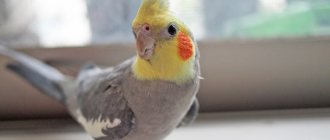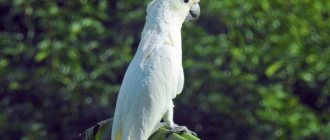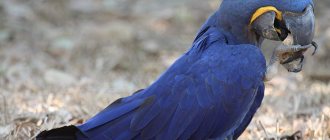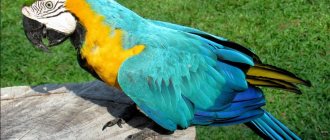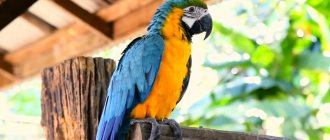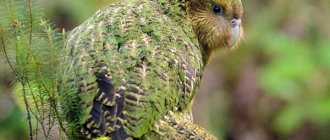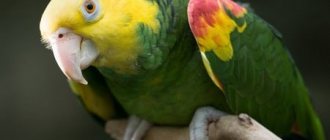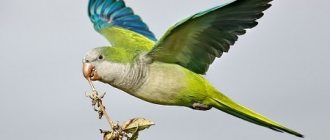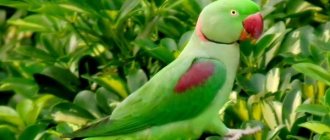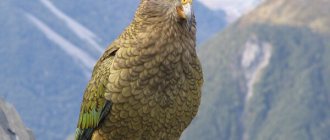There are a huge number of different animals and beasts on the globe. A number of them exist only in the wild; a number are started by people. Among the latter, parrots occupy far from the last place.
These feathered pets come in a variety of colors (from bright green to deep black), have different mental abilities (some easily learn human speech and even tricks, others can only chirp happily), behave differently (actively moving around the cage and quickly flying around the room or striding importantly across the floor.There is also a great variety in size - from small wavy ones to real giants, which will be discussed in this article.
Hyacinth macaw
A fairly well-known breed of parrots, which is distinguished by its blue plumage, and also has yellow feathers around the eyes and under the beak.
A fairly common second name for hyacinth macaws is “gentle giants.” The length of the body together with the tail can reach a meter (the second can be equal to half this value, and the weight reaches up to two kilograms. At the same time, their character is very soft - they are affectionate birds, they trust people and treat them with tenderness. Hyacinth macaws are often used in circus performances because of their ability to train and carry out various commands. But they rarely manage to repeat human speech. There are very few birds left in this nature, which is why it is extremely difficult to find them in the wild, and to acquire them as a pet almost impossible. If you manage to find a nursery or professional breeder, you will have to pay at least $30,000. In many countries, every effort is being made to restore the population, but this is not a quick process, it is quite possible that hyacinth macaws will soon reappear in the wild .
Red Macaw
Very beautiful parrots, painted predominantly in bright red, except for the uppertail and underwings, which are bright blue, only a yellow stripe runs across the wings. They have light cheeks with a row of white feathers. Their body length is from 78 to 90 cm, and they also have a luxurious tail of 50-62 cm. They weigh up to 1.5 kg. Its place of residence is Mexico, Bolivia, Ecuador, the Amazon River, prefers tropical forests, and chooses the crowns of tall trees to live.
The red macaw feeds on nuts, fruits, young shoots of bushes and trees, and often causes significant damage to plantations by eating crops. Once upon a time, Indians hunted them, ate their tasty meat, and made arrows and jewelry from their feathers. They live up to 90 years.
Blue and yellow macaw
The feathered bird has very bright plumage and at first sight wins the love of people.
This is also a large representative of the species with a body length of up to 95 centimeters and a body weight of up to a kilogram. The upper part of the breast is bright blue, the rest of the body is orange-yellow. Against a contrasting background, the bird looks inimitable. A distinctive feature is the extraordinary mind, which allows the bird to learn words and even sentences without problems. Loves to communicate with people or other parrots. This is one of the most popular breeds of birds purchased as pets. Owners note a loud voice, a persistent desire to be in charge and a constant demand for attention as the main disadvantages of the breed. But these problems can be eliminated thanks to education, especially if you do it immediately after purchasing a young chick. You will have to pay at least one and a half thousand dollars for the purchase.
What you need to know before bringing such a parrot home
The parrots mentioned above are a delight to watch, but they are hardly suitable for beginners.
Experienced poultry farmers who want to acquire exotic birds should remember the following nuances:
- Tendency to diseases (even with ideal care, it is almost impossible to protect a pet from illness, and in the case of large birds it is even more so; besides, treating a large parrot will cost many times more).
- Arranging a place to live (birds need large enclosures, creating a comfortable microclimate, walking areas).
- Organization of proper nutrition (large parrots eat a lot, and some species find it difficult to choose a diet close to the natural diet that would fully ensure normal life activities).
- The financial component (the cost of the parrot itself, as well as material investments for the arrangement of enclosures and ongoing care).
Therefore, before you get an exotic feathered pet at home, you should weigh all your options and think about the correctness of such a decision.
Every animal or bird requires a lot of attention and care from humans, because, as you know, we are responsible for those we have tamed. But you also need to understand that the larger and more exotic the pet is, the more effort and time it will take to care for it.
Macau Macau
A very large bird, which in adulthood can grow up to ninety centimeters, with the tail occupying two-thirds of the entire length.
The weight usually does not exceed a kilogram. The feathers are usually bright red, the tail on top and the wings are blue. In addition to beauty, birds have fairly well-developed mental abilities. They are easy to train and can learn more than a hundred words. However, they are rarely seen as pets. The main problem lies in the large number of subtleties that need to be paid attention to during grooming, as well as the very loud voice that gets on the nerves in the room. Also, very few people can pay about three thousand dollars for a pet, which also makes a certain contribution to the popularity of the Macau Macaw.
Everything you need to know about big parrots
When purchasing large birds, we must not forget about the peculiarities of breeding and maintenance. You need to consider the dimensions of your feathered pet and buy an aviary or cage. For Amazons and Grays, the size of the house should be at least 45x45x70 cm. Such cages are sold in pet stores. If the choice is a macaw or cockatoo of large varieties, you need an aviary for large species. Sometimes you cannot find a cage of a suitable size on the market, so you need to order it.
A cage or aviary is not all the needs of poultry. Large parrots need special toys. Perches, drinking bowls, feeders, and swings are also needed to spend time productively while the owner is away.
Yellow-eared mourning cockatoo
One of the representatives of black cockatoos, which differs from individuals from this subfamily by yellow spots on the head (somewhat reminiscent of ears), as well as stripes along the tail.
The nickname “mourning”, which later became part of the name, appeared after a remark by the scientist George Shaw. This was facilitated not only by the color of the feathers, but also by the loud cries of the bird. The bird's height is not the greatest, a little more than half a meter - 55-60 centimeters. The weight reaches one kilogram. Because of this, the speed of the mourning cockatoo is low, but its endurance can be envied. The cost of the bird reaches thirty thousand dollars.
Moluccan cockatoo
The birds are white, but on the neck, head and belly there is a pink tint mixed with the white color, and the undertail is yellow with an orange tint, the underwings are also pink-orange. On the head there is a tuft 15 cm high. It grows up to 46-52 cm, weighs about 850 g. Lives in Indonesia.
Unfortunately, the number of Moluccan cockatoos is constantly declining due to illegal catching, as well as other unfavorable factors. Birds prefer tropical rainforests. They can live both in pairs and in a flock, which usually numbers no more than 20 individuals. Cautious, they prefer tall trees to live.
Black cockatoo
The black cockatoo has the largest beak of any parrot.
It can also be recognized by its characteristic black plumage (there are individuals with a greenish or gray tint), red cheeks and a sharp crest. The size of the bird is not the most impressive, size up to 80 centimeters, weight about 1 kg. At the same time, the beak grows up to 9 centimeters in length. The peculiarity of black cockatoos is in sexual differences - females are larger than their partners, although most often everything is different. These birds do not have the most pleasant voice - it is creaky, harsh and shrill. Learning to repeat human words is very difficult. Buying black cockatoos is recommended for people who are ready to face various difficulties while keeping them.
In order for a young chick to grow into an easy-going bird, it is necessary to constantly educate it. The black cockatoo loves to show its independence, but requires its share of attention. With a competent approach to upbringing, the bird will become not just an expensive pet, but also a true friend. They talk about the cost for a reason - the price for a chick exceeds twenty thousand dollars.
Features of keeping large birds at home
First of all, it is a cell. A large bird requires a large living space, and some species can only live in enclosures. In cramped conditions, large parrots immediately begin to experience serious stress, and at the same time get sick.
The optimal cage size, for example, for a cockatoo is 100 x 100 x 170 cm . However, ordinary options will not work here. All large birds have the same large and powerful beak. They easily bite through thin metal rods. Therefore, the cage must be durable, and such ones can only be found in the premium segment.
It is also worth considering that large parrots have a high level of intelligence, and it requires an outlet. If the owner does not have enough time to communicate with the pet, then he should organize leisure time. That is, provide toys and other entertainment accessories. Just a mirror, bells and a ladder are not enough here.
Kakapo
The owl parrot is the largest representative of this species of birds.
The weight of the bird can reach four kilograms, and the maximum body length is only 60 centimeters. Due to evolution, the kakapo does not fly. In return, the bird acquired strong legs, thanks to which it runs quite quickly. Despite not the most athletic body, the owl parrot's endurance is excellent. Externally, the head of the bird is similar to the head of an owl; kakapo also prefers to be active at night. Individuals of this species have yellow-green plumage and a small number of dark spots. At the moment, there are just over a hundred of them in the wild, which makes it unrealistic to purchase a bird as a pet.
Kakapo, or owl parrot
flickr/eyemac23
Kakapo, or owl parrot (lat. Strigops habroptilus) is a rather rare parrot, large and even heavy in build. The kakapo has lost the ability to fly actively. Prefers to walk more than fly. Its body length is 60 cm, and its weight is about 4 kg. This type of parrot has a pleasant and strong odor that resembles the aroma of flower nectar or honey.
Yellow-crested cockatoo
The body size is about half a meter and the weight is up to a kilogram.
The weight of females is slightly greater than that of males. Most of the body is painted white, the crest, parts of the wings and tail are yellow. Birds prefer to fly short distances, preferring to climb trees. Flying between the trees, the birds show off their ability to fly; they perform various tricks, turning over in the air, and flying sideways. Because of their love for various tricks, birds can often be seen in circuses. Birds of this breed are often purchased as pets, despite the price of more than one and a half thousand dollars. The bird is easy to tame; thanks to proper upbringing, it becomes good friends with its owners.
Great white-crested cockatoo
A dazzling white bird with only yellow underwings and undertail. The legs and tail are grayish-black. On the head is a magnificent crest, which, when raised, forms a crown. It weighs about 600 g, the body length is from 45 to 50 cm, and the tail is 20 cm.
The large white-crested cockatoo prefers forests, mangroves, swamps, and cutting areas of the Moluccas archipelago. It lives either in pairs or in a flock, which can include up to 50 individuals. These birds prefer to lead a sedentary lifestyle, but if there is not enough food, they can migrate.
Brilliant Laurie
A fairly common species of birds that lives in the forests of China, India and New Guinea.
Loris have bright plumage, but their body structure is similar to ordinary chickens. The body length is from 30 centimeters to half a meter. Females are slightly smaller than their chosen ones. The price of a parrot ranges from 250 to 600 dollars; it can be purchased at a specialized nursery or from a professional breeder. They are quite easy to train and learn human speech. The main thing is to pay enough attention to the bird.
Advantages and disadvantages of keeping large parrots at home
It’s worth looking at the situation soberly and objectively assessing the pros and cons of having such a companion in your life.
It should be noted that it is preferable to keep large parrots in aviaries. Find out about the features of an aviary for parrots.
The advantages of keeping these birds are as follows:
- Pronounced ability to imitate speech and conversation in many species.
- Sociability, sociability, attachment to the owner.
- Bright appearance, pleasing to the eye (in most species).
- High intelligence, ability to learn and perform tricks.
- Long life expectancy - with proper care, you will find a friend for more than a dozen years.
- General advantages of keeping parrots: cleanliness, lack of smell, ease of cleaning, no need for walking.
On the other hand, keeping a large bird is associated with some objective difficulties and features:
- Very high cost. However, some species can be very difficult to obtain.
- The lack of professional ornithologists and the high cost of an appointment if medical assistance is required.
- The need for sufficient space (a large cage, sometimes even an aviary or a separate room in the apartment, plus perches in all rooms).
- A strong, harsh, sometimes unpleasant voice that the pet will demonstrate very often. If you don't like noise, large parrots are not for you.
- Curiosity and activity, together with a powerful beak, mean that at times the pet will damage furniture, objects in the house, and clothes. He will also move things from place to place, chew, and disassemble for parts.
- Risk of being bitten or injured. Given the bird's large size, weight and strength, as well as changes in mood and personality, damage can be significant.
- The need for constant (!) communication. Parrots are flocking birds, and if you have no time to take care of your pet, you are constantly at work or do not want to devote enough time to your bird, the result can be sad. If a bird does not receive enough attention, it develops depression and self-plucking, which sometimes leads to fatal consequences due to severe bleeding.
Spix parrot
It is rightfully considered the most expensive and rare bird on Earth.
It is almost impossible to acquire the Blue Macaw - at the beginning of the twenty-first century the bird became extinct in the wild. At the moment, ornithologists are trying to increase the number of individuals, this work is slowly bearing fruit, and one day Spix parrots will appear in the wild. The body length of blue macaws can be up to 60 centimeters. Weight – up to half a kilogram. The body is mostly blue-blue, slightly lighter on the belly and chest. In the wild, it lives in Brazilian forests near rivers.
What were the habits and lifestyle of the parrot?
Many scientists call New Zealand “the island of giant birds and animals.” Previously, archaeologists have found here the fossilized remains of huge eagles, moas and even bats. Researchers also found fossils of parrots on the island, but they were still relatively small birds.
The life of the Hercules parrot recently discovered on the island, according to scientists, was quite complex in prehistoric times. This heavy bird most likely could not fly. Perhaps the huge parrot could fly into the air. But in any case, he flew with great difficulty. The feathered Hercules had to look for food for himself mainly on the ground. At the same time, such a huge bird required a lot of food.
“Creativity and Creativity”: Rosobrnadzor is thinking about transforming the Unified State Exam
First country in the world to vaccinate its entire adult population
Coincidentally or not: why Lady Di put a necklace on her head, which upset the queen
Scientists believe that the only thing that made life easier for Heracles inexpectatus, who was forced to search for food all day long, was his intelligence. As you know, modern parrots, along with crows, are the most intelligent representatives of the bird world. And in the ability to think several steps ahead, the ancient giant was most likely not inferior to his modern counterparts.
Millions of years ago, Hercules ate, according to experts, mainly berries, fruits and seeds of plants that grew in the prehistoric forest in which he lived. This bird could also catch some insects, although such food, as is known, is not the main food for parrots.
Blue-faced Amazon
The homeland of this species of birds is the Lesser Antilles. The maximum body length is about forty centimeters. They are rarely found in the wild (as well as as pets), so acquiring a representative is extremely difficult. The color of the head is bright blue, the body has mostly green plumage, and there are red spots on the neck and chest. A distinctive feature can be considered the beak - it looks like a pigeon.
Content Highlights
If you still haven’t given up on the idea of acquiring a large winged friend, it’s worth learning about the basic aspects of care and maintenance so that your pet is as comfortable as possible with you.
Important! Statistics show that only a quarter of parrots survive to old age in captivity and die a natural death. The majority (60%) die as a result of improper care, disease and injury.
Cell
It is advisable to keep the largest representatives - macaws and cockatoos - in an aviary or a separate room. However, given that the pet will spend about 90% of its time outside the house, you can equip a cage for it.
Be sure to take into account not only the length of the body, but also the wingspan. For these breeds, the dimensions are as follows: 100*100*170 cm, for smaller varieties the parameters 65*50*80 cm are suitable.
The bars of the cage must be made of high-quality durable metal with a thickness of at least 4–5 mm, otherwise the parrot will easily damage or chew them. The cage must not be painted or galvanized. Also, take care of a reliable lock on the door - due to the bird’s natural intelligence, strength and curiosity, it will not be difficult for the bird to open the lock.
Accessories
In addition to the cage itself, you need to purchase many more accessories:
- Feeder. Can be external or internal. It is advisable to choose feeders made of high-quality and durable stainless metal.
- Wooden perches and squats. They are available on sale from a variety of materials (textiles, pumice, cement, plastic), but wood is preferable because of its safety and environmental friendliness. Keep in mind that parrots simply love to chew on them, so be prepared to replace several perches every day and remove splinters of broken wood underneath them. Therefore, it is better (more economical) to make them yourself.
- Drinking bowl. Must be placed inside the cage. You cannot use open drinking bowls, because the water in them will immediately become contaminated with droppings. It is better to opt for vertical containers with a pocket at the lower end.
- Mineral stone. Necessary to meet the body's needs for micro- and macroelements. Attached inside the cage.
- Toys. A large number and variety of toys will not allow your pet to get bored and will reduce the likelihood of damage to prohibited (valuable) items in the house.
- Net. Required to catch the parrot until you tame it.
- Taming stick. It looks like a long plastic pole (100 cm) with a fork at the end. Fruits are placed on it and offered to the bird. By gradually reducing the distance from the fruit to the palm, you can tame your pet.
Yellow-headed Amazon
The homeland of yellow-headed Amazons is the forests of Central America and Mexico. The body length reaches forty centimeters, weight – up to half a kilogram. The plumage on the head is yellow, the wings may have red feathers. Thanks to their large beak, they can easily cope with nut shells, getting to the tasty kernels. It is on the verge of extinction; about six thousand representatives of this breed live in the wild.
Large vase parrot
It has nothing in common with this decorative household item. It received this name “vase” due to the linguistic characteristics of the local residents. It lives on the Komodo Islands and in the forested parts of Madagascar.
From a distance it may resemble a bird of prey of the eagle species, but its huge, strong beak makes its presence felt. Its massive body can reach up to 50 centimeters This parrot weighs about one kilogram. Despite the fact that it is somewhat similar to a predator, it does not engage in predation, but is capable of cracking the shell of a large nut in a matter of seconds.
Cockatoo alba
The second name of this bird is white-crested.
The body length of an adult bird reaches half a meter. Sometimes there are individuals up to 70 centimeters in size, but they are not common. The popularity of this species is due to its very beautiful plumage, as well as constant activity and the ability to repeat human speech and perform various tricks. Alba cockatoos love their owners very much, constantly require their attention, love to hug and caress. Due to loneliness, they attract attention by loud chirping. The price ranges from one thousand seven hundred to two and a half thousand dollars.
Keeping large parrots
The largest parrots in the world are in high demand, despite their high cost. This is due to their beautiful appearance and unique character, which is distinguished by good nature and friendliness. The bird loves to be in society and constantly communicate with people.
If you decide to have a large parrot at home, then you should consider several important recommendations:
- cell selection. This is an important condition for keeping a feathered pet. Preference should be given to spacious options in which the bird can fly and move. The cage must be made of a metal base, because plastic and wooden products have a short service life. It is better that it be vertical;
- If the size of the house allows, then it is better to give your feathered pet a separate room. In it he will be able to fly, play, and move freely. He will feel freedom, which will have a positive effect on his condition;
- Don’t forget about feeders and drinkers. The dimensions should allow the bird to calmly get food without touching the edges with its beak;
- Perches made of natural wood should be placed in the cage. They are necessary for the bird to play and move. The diameter of the pole must correspond to the size of the parrot’s paws so that he can grasp it freely;
- It is imperative to provide adequate nutrition; it is the basis for the full development and growth of the bird. Large parrots will happily eat seeds, nuts, millet, wheat, fresh fruits, vegetables, and berries. They love currants, raspberries, gooseberries. Among the vegetables, it is worth highlighting tomatoes, cucumbers, beets, and corn. Sometimes you can include melon, watermelon, and banana in your diet. They will be happy to eat apples and pears.
Of course, these are not all the requirements that must be observed when keeping large parrots. It is important to regularly clean the place where they are kept, change the water and add food. Don’t forget about full communication and plenty of attention; feathered pets love communication. They are easy to train and quickly remember commands, so feathered pets can quickly become a true friend and helper for their owner.
If you liked the article or have something to add, then leave your comments and also join our VKontakte group.
Comparison
The sizes of representatives of the above list fluctuate in a fairly large range. However, a parrot is considered large when its body length is at least forty centimeters. The upper limit is about a meter. The weight also varies from half a kilogram to four. Birds are similar in that the number of individuals in the wild is not very large, which is why the cost of an individual bird can be quite high (from a thousand dollars). For a visual comparison of sizes, you can use a special table
| Breed | Height (in cm) | Weight (in kg) | Life expectancy (in years) | Cost (in dollars) |
| Hyacinth macaw | Up to 1 meter | Up to 2 | 35-40 | From 30000 |
| Blue and yellow macaw | Up to 95 | Up to 1 | 30-35 | From 1500 |
| Macau Macau | Up to 90 | Up to 1 | 35-40 | ~3000 |
| Yellow-eared mourning cockatoo | 55-60 | Up to 1 | About 45 | ~30000 |
| Black cockatoo | Up to 80 | Up to 1 | 30-40 | From 20000 |
| Kakapo | Up to 60 | ~4 | 90-95 | Impossible to purchase |
| Yellow-crested cockatoo | Up to 50 | Up to 1 | 60-80 | From 1500 |
| Shiny loris | From 30 to 50 | Up to 0.5 | 20 | 250-600 |
| Spix parrot | Up to 60 | Up to 0.4 | 10-25 in the wild, up to 50 at home | Impossible to purchase |
| Blue-faced Amazon | 35-42 | 0,4-0,52 | 70-80 | 900-1500 |
| Yellow-headed Amazon | 38-41 | 0,54-0,7 | 40-50 | 1000-1500 |
| Cockatoo alba | 45-50 | 0,5-0,6 | 70-80 | 1700-2500 |
Top 10 most famous species with photos
Among other wild representatives of the family, ornithologists have identified several large birds that adapt well to life in captivity and can please the owner not only with their impressive size, but also with their intelligence.
White cockatoo Alba
The body length of the largest bird does not exceed 50 cm and weighs 600 g . The plumage is bright white, and yellowish zones can be seen in the underwing zone. One of the notable features of the cockatoo is the presence of a crest, which acts as an indicator of the parrot's mood.
The species is distributed on the Indonesian group of islands. The bird prefers to inhabit forests near bodies of water. Animals lead a sedentary lifestyle, gathering in groups of 40-50 individuals. If there is a lack of food, they can migrate to neighboring islands.
White cockatoos form pairs for life. If one of the partners dies, the other becomes severely depressed and subsequently makes no attempt to find a replacement.
The cockatoo is trusting and easily makes contact with people. He has a natural artistic gift and is also able to learn up to 20 words. In captivity, with proper care, the bird's life expectancy is about 50-70 years.
Moluccan cockatoo
The body length of a mature animal varies between 46-52 cm and weighs 850 g. The dominant color of the plumage is white. The chest and abdomen are highlighted in a pale pink shade. The male is no different in color from the female. The length of the crest reaches 15 cm.
The main population is concentrated in the Moluccas . The parrot inhabits tropical rainforests and coastal areas. The animals keep in small groups of 20 birds, split into pairs. The number of representatives of this species has dropped below 10,000 individuals. Since 1960, the Moluccan cockatoo has been listed in the Red Book.
The parrot easily adapts to life in captivity and quickly gets used to human hands. The bird is intelligent, but problems arise when imitating human speech. The maximum you can count on is a dozen words and phrases. The life expectancy of a pet is 50-80 years.
Black palm cockatoo
The bird's body length is about 80 cm and weighs 900 g. The predominant color of the plumage is black and slate. A greenish tint can be seen in the rays of the sun. A notable feature of palm cockatoos is their large and at the same time powerful beak, growing up to 9 cm. The crest consists of ribbon-like feathers curled back. Scarlet-red areas are noticeable on the cheeks.
The parrot lives in New Guinea and northern Australia, inhabiting savannas and tropical forests. Birds can survive either in groups or alone. In search of food, they deftly maneuver through dense thickets of tall trees.
The voice of the black palm cockatoo is quite unpleasant: loud, harsh and squeaky. Especially in an excited state.
The bird is most often kept in zoos. The powerful beak of a cockatoo can bite through 5 mm thick metal rods. Therefore, the only place from which a parrot will not escape is an aviary with a strong lattice. The pet is quite demanding in terms of training and training: mistakes can provoke aggression.
In addition, palm cockatoos are vindictive and remember everything that a particular person has done. However, the bird is considered one of the smartest among other members of the family. She is capable of performing very difficult tricks for birds.
Greater yellow-crested cockatoo
The body length reaches 50-55 cm with a weight of about 950 g. The dominant color of the plumage is white with rare yellow accents: flight and tail feathers, crest. The size of the beak is proportional to the size of the bird and is strongly curved.
The largest populations are found on the islands of Tasmania, New Guinea and the northern part of Australia. The parrot prefers eucalyptus forests and savannas with tall, dense trees located near bodies of water. Both parents, not just the female, participate in the arrangement of the nest. The bird feeds on fruits, nuts, and plant buds, but does not hesitate to fly onto farm lands.
The yellow-crested cockatoo has great difficulty imitating human speech and is not able to master more than 10 words. But the pet perfectly copies other sounds: barking dogs, meowing, simple musical compositions, the operation of household appliances, etc. Like other cockatoos, the yellow-crested cockatoo has innate artistry, which is why it can often be seen at circus performances. The bird's lifespan is about 50 years.
Yellow-eared mourning cockatoo
The bird's body length fluctuates around 60 cm and weighs almost a kilogram. The plumage is dark brown, and rare light spots are scattered throughout the body. There are several yellow stripes at the tip of the tail. Unlike other members of the family, mourning cockatoos have virtually no crest.
The main population of birds is concentrated in eastern Australia and the islands adjacent to this part of the mainland. The animal's diet consists of insect larvae and plant seeds. Ornithologists do not recommend considering mourning cockatoos as pets. The parrot is picky both in content and in training. The bird is suitable only for experienced breeders.
The female mourning cockatoo lays 1-2 eggs, and the male provides her with food. As a rule, only one chick survives. Moreover, it remains in the nest not for 30-60 days, like other parrots, but for about six months.
Hyacinth macaw
The length of mature individuals can reach 90-100 cm , and the weight of domestic animals often exceeds 1.5 kg. The plumage of this huge parrot is matte cobalt blue. Bright yellow stripes are visible around the eyes and above the beak. The beak looks hypertrophied considering the size of the bird. With its help, she easily cracks nuts and other hard objects.
The habitat of the hyacinth macaw is Brazil, Paraguay and Bolivia. The parrot inhabits palm groves and forest plantations near bodies of water. Birds live in small groups of a dozen individuals each. In search of food, they can fly over an area up to 10 km away. The animal's favorite delicacy is berries, figs and snails.
Despite its complex nature, the hyacinth macaw is easy to train and relatively quickly gets used to human hands. The parrot imitates sounds well, including human speech: its vocabulary is limited to 40-50 words. Life expectancy is about 40-50 years.
The hyacinth macaw is endangered. At the beginning of the 21st century, the number of wild birds had decreased to 6,000 individuals. Therefore, the species is listed in the Red Book.
Red Macaw (Macao)
The parrot's body length is 80-90 cm and weighs 1.2 kg. The coloring is the calling card of the red macaw. Most of the plumage is painted bright red, the rest of the area is combined in blue, yellow and brown shades. The beak and part of the head have white areas.
The bird population is dispersed from Mexico to Uruguay. The red macaw inhabits tropical forests, nesting high in the treetops. The main diet of the animal is plant food: seeds, nuts and fruits. It also does not disdain insects.
In search of food, the parrot may fly into farmland. Given its gluttony, it causes serious damage to agricultural crops. The bird can cover about 15 km in a day. Partners become attached both to each other and to the nesting site.
The Indians hunted the red macaw for a living. Feathers were used to make arrows and organize ritual ceremonies, and parrot meat was considered a delicacy.
The bird quickly adapts to captivity and easily gets used to human hands. With the right approach, the red macaw can learn up to 100 words and consciously use phrases. The parrot is also capable of performing complex tricks. Life expectancy in captivity is about 40-50 years.
Blue and yellow macaw
This is one of the most popular among other large domesticated birds. The parrot's body length is 80-90 cm, and its weight reaches 1.3 kg. The plumage is dominated by two colors - yellow and blue, visually dividing the body into two parts. There are two white areas with black stripes on the head. The beak is massive and powerful. With its help, the parrot not only cracks nuts, but also easily bites through wooden branches.
The bird lives from Panama to the southern regions of Brazil, preferring to nest in tropical forests closer to water. Sometimes found in mountainous areas. The animal becomes strongly attached to its habitat and only leaves it in case of extreme need. In search of food, it can travel up to 25 km. Birds do not form groups, living exclusively in pairs.
Taking into account other representatives of the parrot family, the blue-and-yellow macaw has a well-developed intellect. The pet is non-aggressive, quickly learns tricks and almost perfectly imitates the human voice. Life expectancy is 40-50 years with proper care.
Blue Spix parrot
The body length of an adult is about 55 cm and weighs 400 g. Externally, the bird looks faded compared to its colorful relatives. The dominant plumage color is dark blue. The head is slightly lighter, and light blue zones can be seen on the abdomen.
The habitat of the blue parrot is Brazil. But, alas, this species is no longer found in the wild. The last specimen was seen in 2000. A little earlier, ornithologists tried to introduce domesticated animals from private collections into their natural habitat. But the birds died.
The reason for the disappearance of blue parrots lies in poaching and cutting down of the birds' favorite nesting places - tabebuia trees. Blue parrots used the same flight routes year after year that poachers took advantage of. African bees are also to a large extent to blame, having occupied hollows suitable for breeding birds.
Judging by the declarations of breeders, there are only 500 birds of this species left in the world . But it is extremely difficult to restore the former population, because there is a high risk that the existing animals are of related blood. Moreover, only 80 pets out of 500 are in the working group for resuscitation of the species.
Owl parrot
Another name for the species is kakapo. This is a real giant among other representatives of parrots. The body length reaches 60 cm, and mature individuals weigh 3-4 kg. The plumage is very soft to the touch, with a yellow-green tint. The beak is disproportionately large, slightly curved and very powerful.
The bird lives in New Zealand, preferring to nest in dense forests with high humidity. Parrots are nocturnal: during the day they hide from the eyes of predators, and in the evening they go out hunting, hunting for berries, shoots and plant juice.
Kakapo is the only parrot that cannot fly. But the underdevelopment of the wings is compensated by strong and hardy paws, capable of covering an impressive distance, as well as tearing apart dense thickets. Dug holes under trees or in rock crevices serve as nests.
The bird is unsuitable for home keeping, so most often it can be seen in zoos and in large enclosures of professional breeders. The parrot boasts a high level of intelligence, but imitates sounds with great difficulty.
The species is on the verge of extinction. Today, about 150 wild individuals have been recorded. A specially created organization, Kakapo Recovery, is engaged in restoring the population, breeding approximately 30-50 chicks per year starting in 2022.
The largest parrots in the world
In captivity, only a few species of large parrots can be kept. The conditions of detention are determined by the characteristic features of their character and behavior.
Macaw
The largest parrot in the world of all parrot-like birds. The length of its body can reach from half a meter to one. Lives in the forests of America, in its southern and central parts. The macaw is an intelligent bird, very smart and well trained. Easily copies extraneous sounds, for example, the creaking of a gate, a patient’s cough, or a dog barking. With systematic training, she is able to learn a large set of words and short phrases. This talking parrot is very interesting to train, but is rarely seen at home. Keeping an eye on such a huge bird, especially during free-ranging hours, is quite difficult.
Cockatoo
This large white parrot with a tuft is simply beautiful. The crest contrasts with the main color of the plumage. In moments of intense emotion, he straightens up greatly. Its beak is also unusual. It looks like a ladle because the lower part of the beak is wide compared to the upper. Body size 40-60 cm. The bird's homeland is Australia and New Guinea.
Amazon
In nature, this species of parrot lives in the south and central part of America. The size of the birds is 25-45 cm. The plumage is green, sometimes interspersed. Under good conditions they live up to 70 years. Ornithologists have counted 29 species of Amazons. These parrots are well suited for beginner bird lovers. They are not that big in size and are easy to train. Their characteristic features are great curiosity, friendliness and intelligence. Constant training with the bird will give a positive result in the form of a couple of dozen new words and phrases.
Jaco
This species is also perfect for home keeping. Jaco is the most talkative parrot, with a talent for onomatopoeia. Thanks to their good memory, they quickly learn frequently spoken phrases. They love to repeat the sounds made by the phone. The size of the parrot is smaller than large representatives of other species and is 30-35 cm. The body color is ash-gray with a bright crimson tip of the tail. The lifespan of some individuals can reach half a century. The western region of Africa is their homeland.
Vase
The Comoros Islands and Madagascar are the areas where these birds live. Their size ranges from 35-50 cm. The vase has a rather simple appearance. The body plumage is gray-black, and the tail has a brownish tint. Bird breeders prefer to breed more colorful representatives. Therefore, this species is not particularly popular. But those owners who purchased these birds speak of them as sociable and friendly creatures.
Owl parrot (kakapo)
The bird acquired its name due to its resemblance to an owl. Her homeland is New Zealand. Once upon a time, her enemies did not exist in this territory. Because of this, the ability to fly was lost. This is the only representative of the parrots that does not fly. But with the importation of dogs and other animals, the number of kākāpō declined sharply. Body length is about 60 cm. In terms of their weight, which is 3-4 kg, these birds are the heaviest among their fellows.
Large and medium parrots
During the research, it was possible to establish that there are more than 300 species of parrots. Most of them live in Australia, South and Central America. At the moment, cockatoos, budgerigars, lovebirds, corellas, grays, macaws and amazonas are common among poultry, although more unusual and larger varieties are now most often preferred. Large pet parrots will be an excellent decoration for any home, these include:
- Hyacinth macaw.
- Black cockatoo.
- Blue and yellow macaw.
- Owl parrot kakapo.
- Yellow-crested cockatoo.
Each of these varieties of large parrots has a number of features; each of them should be considered in more detail. Medium-sized parrots are the best option for novice owners of ornamental birds. In this case, the pet must be placed in a medium-sized cage and provided with all the necessary accessories. Medium-sized parrots include the following types of parrots for home keeping:
- Colella.
- Lovebirds.
- Ringed parrots.
- Laurie.
- Senegal parrot.
Corella
This variety of parrots is one of the most common among medium-sized ones. The bird has an unusual appearance, distinguished by a characteristic crest, which makes it look like a huge cockatoo. Adults grow up to 35 centimeters and weigh about 100 grams. The efforts of breeders have made it possible to obtain individuals with different colors, for example, white cockatiels are often found.
Corella parrot grows up to 35 cm
The parrot is remarkably domesticated; it requires almost no effort, the main thing is to treat the bird well. She makes excellent contact and will accept not only people, but also pets living in the house. Many people are put off by parrots' reluctance to imitate human speech, which is why cockatiels are not classified as talking parrots. They can pronounce very simple phrases, but their pronunciation will bear little resemblance to normal speech. Although he can whistle different songs and even complex melodies. The bird has a shrill and sharp voice, which it uses very rarely, so the parrot will not irritate the residents of the house with its “singing”.
Types of pet parrots
Domestic parrots are:
- Large (macaws, grays, cockatoos, Amazons).
- Medium (cockatiels, lorikeets).
- Small (budgies, lovebirds).
Types of talking parrots:
Budgie
The most popular type of domestic parrot. They are often owned by families with small children. They can be kept singly, in pairs or in several pieces. These birds belong to the talking species of parrots. They make virtually no noise
They love attention from humans, quickly get used to being handled and easily learn various tricks. They are very easy to care for
Budgerigars are small in size, so they do not require a large cage. They live from 10 to 25 years.
Corella
This is a medium sized bird. Another name for it is nymph. Good for families with children because even if they bite, it will be completely painless. They have a calm character and quickly get used to their cage. A distinctive feature of this bird is the crest on its head.
. In our country, this species is considered the second most popular for keeping at home, after budgerigars. Corella loves to interact with people. She is easy to tame, but she is not very willing to talk and can only learn a few phrases.
Lovebirds
These birds come in two varieties:
- White-bellied Caique.
- Black-headed caique.
They have beautiful plumage and get along well with people.
. Unpretentious in maintenance, very active and mobile. It's a pleasure to watch them. However, they cannot be taught to speak words. They got their name because they can only live in pairs, and they choose one partner for life. They often sit close to each other. They can live up to 20 years.
Jaco
The most gifted species among parrots. According to the results of research, it was found that he has the mind of a five-year-old child
. Having a calm character, he quickly gets used to people. Refers to a species of talking parrots. Able to pronounce not only words, but also entire sentences. They can whistle various melodies and sing songs, imitate the voices of various animals very well and accurately copy the voice of their owner. They perfectly copy various sounds, for example, a telephone call.
Jaco considers himself a full member of the family. He is very sensitive to how his owners treat him. He might even get offended and then start screaming very loudly.
. Any change in his life causes severe stress in this bird, even if it is a simple rearrangement of furniture. As a result, the Gray begins to pluck its feathers. Therefore, you need to be very careful when making any changes. They can outlive their owners, living up to the age of 70 years.
Macaw
Belongs to the genus of large parrots
. Due to their large size, they are difficult to keep at home. In addition, they can scream very loudly and piercingly, which not everyone can stand. Their plumage is very beautiful. These birds have little ability to learn to speak, but they pronounce words very clearly and loudly. This type of parrot is easy to train.
If the cage in which this parrot is placed is made of thin wire
, then with the help of its powerful beak the pet destroys it. Therefore, the cage must be welded from steel rods. As soon as the macaw breaks out of his captivity, he is capable of destroying all the furniture in the apartment.
Cockatoo
This parrot has white plumage, a large crest and a black beak.
. They are considered the funniest birds. They comically squat and bow, actively unfolding and lowering their crest. These birds are very loved by all segments of the population. They are easy to tame, but teaching them to talk is very difficult, achieving only a couple of phrases. They can whistle different melodies and imitate different sounds. They open the locks in the cage doors, no matter how clever they are.
These birds are very capricious and noisy. They can be spoiled very much if you carry them in your arms all the time and let them walk and fly around the apartment. After this it is difficult to force them to go into the cage
. When alone, the cockatoo begins to scream continuously and sharply until the owner approaches him. They can live up to 100 years.
Thus, there are a large number of species of parrots that can be kept at home. All that remains is to make the right choice.
Unplanned find
Researchers discovered the giant parrot Heracles inexpectatus in New Zealand completely by accident. Such searches were not conducted purposefully, since specialists had not previously even suspected the possibility of the existence of such a huge species.
In any case, the discovery made in New Zealand, among other things, raised one very interesting question for ornithologists, to which they have not yet been able to find an answer. Modern parrots are known to be relatively small in size. Heracles inexpectatus could reach a modern man's thigh if he stood nearby.
Accordingly, it is not entirely clear to scientists how the evolution of these birds could have proceeded. When exactly and for what reason the parrots were suddenly crushed, experts do not know. Researchers have not yet found transitional species from Heracles inexpectatus to modern parrots.
We make a comfortable duvet cover with our own hands: you will need two sheets
A step-by-step recipe for making cute cakes with an original design and taste
Emigration to the USA and an unsuccessful marriage: how the life of the beauty Natalia Lapina turned out
It was precisely because the discovery of the bones of a giant bird was made unexpectedly that it was named Heracles inexpectatus. In any case, in this name the scientists were able to reflect both the enormous size of the parrot and their own scientific luck.
Cockatoo
This type of parrot can also be classified as the largest.
This is one of those birds that can easily get along with people under the same roof. It should be noted that the cockatoo is completely unpretentious and its maintenance will not cause much trouble for its owners. The only thing your pet will constantly demand is increased attention. Parrots raised by people become very attached to them and get bored when they leave home or pay little attention because they are busy.
Due to their decent size, cockatoos require a spacious cage area. Enclosures must be high and wide so that the bird feels as comfortable as possible. You can feed your cockatoo:
- vegetables (carrots, cucumbers);
- grains (millet, millet, corn, hemp, oats, seeds);
- fruits (bananas, pears, apples);
- berries;
- nuts.
There are special sets of food that are designed specifically for such a large parrot.
They get along great with children. They can learn up to twenty words and use them correctly. They have perfectly mastered the ability to imitate sounds.
If you decide to purchase a similar bird for your family, we advise you to choose a young individual. The earlier a bird is with a person, the calmer its character will be. As you know, this species lives up to a hundred years, so your grandchildren will also be able to enjoy communicating with this amazing creature.
Bright plumage, interesting habits and the ability to copy human speech have made parrots one of the most beloved pets. Together with representatives from the corvid family, or ravens, parrots are considered the most intelligent birds living on Earth. Parrots are very sociable, cannot stand loneliness and get along well with people.
From the huge number of different birds that live on our planet, you can always single out one representative who can be recognized immediately. And in fact, there is not a single person who would not recognize a parrot at first sight. Today there are approximately 300 species of parrots, but today we will talk about the largest of them.
The most expensive parrot in the world
Top 10 largest jellyfish in the world
Having carefully studied the parrot market, it is easy to notice that the most expensive goods on it are two types of birds: the hyacinth macaw and the black palm cockatoo. Each of them differs significantly from the budgerigar known to many, and not only in size.
Did you know? When parrot chicks appear, parents give them names that are perceived by people as a common set of sounds.
However, for the birds themselves it is quite clear who exactly the parents call - sister or brother.
Hyacinth macaw
This is one of the largest representatives of the parrot world, since its body length can reach 90–100 cm, although almost half of this value is in the tail. Such birds weigh about 1.5 kg, but this is not the most interesting value: the length of the parrot’s wings reaches 40 cm.
The color of the hyacinth macaw is cobalt blue, the sides of the head are covered with feathers, and only narrow areas at the base of the mandible and around the eyes remain unfeathered. They have a characteristic golden yellow color. The tail feathers are gray-blue, and the tail itself is long and narrow.
Find out which breeds of parrots are the most beautiful.
It can be heard from a distance of 1–1.5 km, especially if the bird lives in natural conditions. Its natural habitat is the central part of Brazil, Bolivia and Paraguay.
The officially recorded lifespan of this macaw species is 39 years, although much higher figures have been reported on numerous occasions (for example, 54 years or even 60 years).
And finally, the most interesting question: how much does a hyacinth macaw cost? In fact, there are different prices, but if you want to buy such a pet, then be prepared to pay at least $3,000–$5,000 for it.
In elite nurseries of international importance, amounts can reach up to $10,000. True, in this case you get at least some guarantee of good health and purity of the parental lines.
Palm cockatoo
The black palm cockatoo is considered the largest species of parrot found in Australia. The main feature of this bird is its cheeks, which turn deep red when angry.
We recommend reading about what the cockatoo family is like.
This pet can be trained to speak humanly, but its vocabulary will still not be very large, and untamed individuals can show considerable aggression towards humans, so there is no time for talking.
As for the main parameters of representatives of this species, they are as follows:
- body length - 60–75 cm;
- tail length - 23–35 cm;
- beak length - 9 cm (tarsus - 3.5 cm);
- bird weight: males - 540-1100 g, females - 500-950 g.
The plumage color is black, but in the lower part of the body there are red stripes on the tail feathers of males. The bird's voice is very loud and resembles a hoarse squeal or squeak.
Important! Due to its powerful beak, keeping a palm cockatoo is not so easy: it can easily bite through cage bars up to 5 mm thick, and feeding can be called a real adventure, which is explained by the extreme ingenuity of the bird.
The cost of this variety of parrots starts from $8,000 and often reaches 12,000 when it comes to purchasing from reputable nurseries.
Hard work
There are currently not too many scientists in the world who specialize in the study of ancient large birds that lived on the planet millions of years ago. At the same time, the work itself on classifying such fossils is very difficult and expensive.
However, the complexity and high cost of the work being carried out does not at all confuse specialists who are comparing the bones of different species of giant birds found in New Zealand. Scientists simply continue their work, making invaluable contributions to science.
